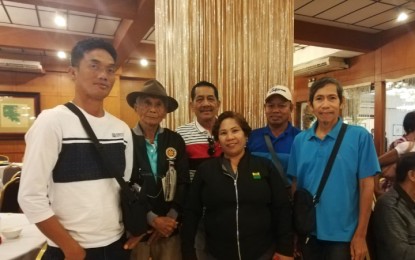
AFFORDABLE HOMES FOR FARMERS. Agrarian reform beneficiaries from Cavite witness the memorandum of agreement between DAR and DHSUD in a ceremony on December 5, 2019. The activity also launched the program that aims to provide homes to farmers who are members of the Comprehensive Agrarian Reform Program (CARP). (PNA photo by Christine Cudis)
MANILA -- Agrarian Reform Beneficiaries (ARB) who are in need of decent and affordable housing are taking advantage of the new program launched by the government through the Department of Agrarian Reform (DAR) and newly-established Department of Human Settlements and Urban Development (DHSUD).
In a recent interview, 47-year old farmer Elino Comia, who hails from Tanauan, Batangas, said he is looking forward to getting a house of his own since he and his brother still live in their parents’ house.
“Napakagandang programa ng DAR dahil makakatulong sila sa ARB na wala pang sariling bahay (This is a wonderful program of DAR so the ARBs who do not yet have their own houses will finally get one),” he said.
Other farmers, who are members of an existing cooperative, are also encouraged to apply for the housing assistance program as most of them still stay in rental spaces.
“If the grantees still cannot afford to bear the financial responsibility that comes from building a house, our cooperative will offer our members a loan or additional source of income to further assist them kasi these farmers have been with us (members) and yet some of them do not have their own houses yet,” said Consuela Agudo, Subasta Agrarian Reform Beneficiaries’ Agricultural Cooperative chair, in an interview.
Agudo estimates that there are at least 20% of their members or 76 farmers who do not yet own any real estate property.
She also shared that she will avail of the loan so her children are guaranteed a house of their own in the future.
Last Thursday, farmers of the Comprehensive Agrarian Reform Program (CARP) witnessed the signing of the memorandum of agreement (MOA) between DAR Secretary John Castriciones and DHSUD Secretary Eduardo del Rosario.
The MOA seeks to pursue a meaningful agrarian reform program by uplifting the lives and economic status of agrarian reform beneficiaries (ARBs) and their families.
The program, called Building Adequate, Livable, Affordable and Inclusive (BALAI) Farmers and Farmworkers’ Housing Program, which is one of the priority programs of the government, aims to improve the living condition of farmer-beneficiaries in the country.
Under the agreement, the DHSUD shall develop and adopt a national strategy to immediately address the provision of adequate and affordable housing to farmers.
The agreement also stipulates that DAR and DHSUD will form project teams to coordinate and implement the housing program in the pilot areas, namely Bayombong, Nueva Vizcaya; San Leonardo, Nueva Ecija; Tuy, Batangas; Daet, Camarines Norte; Argao, Cebu and Davao City.
“After the successful implementation of this housing program in the pilot areas, concerted efforts by DAR and DHSUD to cascade the program down to the provinces and municipalities,” DAR Undersecretary Emily Padilla said.

The housing program, she said, will be a product compilation of existing programs and projects of relevant government and private sector agencies.
“A multi-sectoral approach will be adopted in the implementation of the housing program by converging resources of government and private sector agencies to address the different dimensions of housing, which is not only relating to physical structure but also access to livelihood opportunities, health, as well as the education of children of ARBs,” Padilla said.
Farmers’ housing plans
According to Padilla, the program will be implemented in two schemes, on-site and off-site housing.
Padilla said the on-site housing scheme will cover home improvements of existing houses of ARBs, construction or purchase of a new house for ARBs, and refinancing of an existing housing loan secured by the ARB.
“The farmers’ housing loans will be secured by emancipation patent, certificate of land ownership award, and other titles issued to them. Housing loans for house construction or improvement in lands covered by CLOA will be treated as additional loans by Land Bank of the Philippines and other lending institutions,” Padilla said.
The off-site housing scheme covers subdivision projects located in the capital or in major urban centers of the province.
“Such projects may be chosen by farmers to provide housing for their families, children or relatives so they can be near to schools, medical facilities and market centers for their agri-products,” Padilla said.
She added that subdivision plans and designs will be made in a way that production facilities such as rice and sugar mills, dryers, and warehouses are integrated with places designated for open space such as basketball courts and multi-purpose centers.
The housing units are the duplex type with two bedrooms each, covering 37 square meters.
Padilla said that the housing development will be supplied by subdivision developers and housing contractors.
“The provision of housing is demand-driven and payment will be based on the farmers’ capacity to pay. The maximum term of housing loan will be at 30 years and amortization payment scheme will be based on cropping or harvest schedule of farmers,” Padilla added. (PNA)
